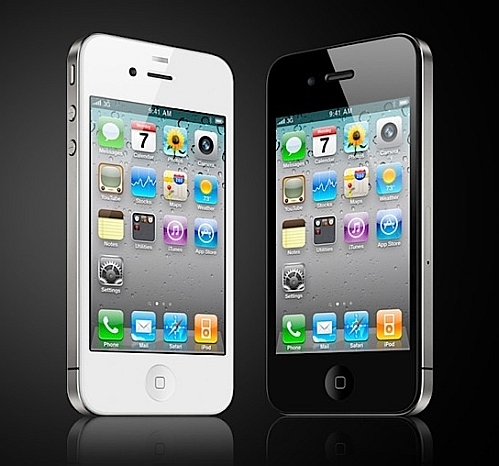Index
![]()

Review: A smartphone that promises it all
In the first half of our iPhone 4 review, we gave a brief historical overview of the iPhone platform since its introduction to the smartphone market in summer 2007, including its booming impact on the global smartphone market over the past three years. We discussed Apple’s design philosophy behind the physical dimensions and aesthetics of the iPhone 4, and we examined the truth behind the much hyped Retina Display.
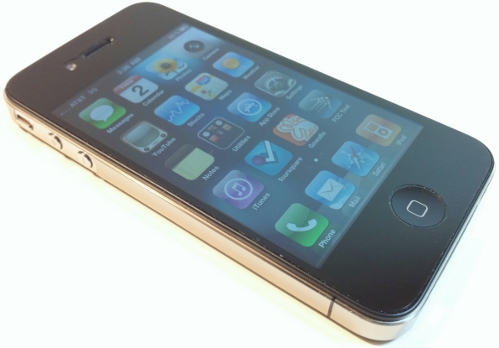
In this half of the review, we will take a look at the real story of the controversy behind the ill-fated antenna design, internal hardware specifications and upgrades from the iPhone 3GS, the improved backside CMOS camera sensor with LED flash and new front-facing VGA camera, battery life with iOS 4 and multitasking, FaceTime chat, and overall market acceptance since launch day.
Antenna design and controversial reception issue
Unlike the previous three iPhone generations, the iPhone 4 sports a new antenna design that is meant to improve reception and overall call quality. The antenna is a split stainless steel band that runs around the edge of the phone. The shorter, left strip is used for WiFi, Bluetooth and GPS and the longer, right strip is connected to the UMTS/GSM cellular radio for voice and data. In perspective, the design can be viewed as a return to some of the earliest phone designs from the 90s that featured external antenna poles and could be manually raised for improving reception. During Apple’s WWDC 2010 keynote, Steve Jobs exclusively noted that this was “some brilliant engineering, [where Apple uses] the stainless steel band as part of the antenna system." Now, if the CEO of the company himself is telling his flock of prospective iPhone 4 consumers to “expect brilliance,” we would sure hope that his words resonated a positive marketing image for the new device when launch day came around. Unfortunately, numerous users have discovered that holding the phone in a certain way (noticeably when grasping it in the left hand) appears to degrade signal, and ultimately drops calls and data throughput speeds.
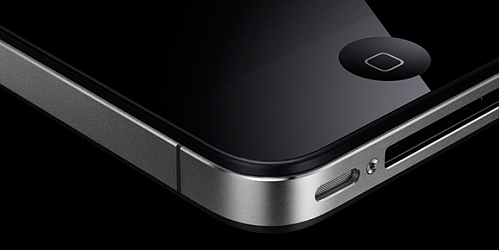
Since the issue has become known, many iPhone 4 users have been carefully monitoring their AT&T 3G HSPA reception. In our personal tests with three different iPhone 4’s, we have found that covering the antenna gap on the lower-left of the device does not seem to affect call quality or cause any dropped calls on two of the phones. On the third phone, however, calls are typically dropped with a stronger than normal palm grip over the antenna gap, even in environments where all 5 bars were displayed before the device was gripped.
AnandTech’s Brian Klug recently conducted a lengthy scientific analysis of the scenario, where he highlighted the potential for both unintended attenuation and detuning being much greater with an external antenna design than with a conventional internal design. Upon acquiring his iPhone 4, the first thing he attempted was to try and run the hidden Field Test application via the widely documented *3001#12345#* dialer code (it’s a nifty utility, give it a try). Unfortunately, Field Test is completely absent on the iPhone 4’s filesystem applications directory and only works on original iPhone, iPhone 3G and iPhone 3GS devices that have not been updated to run iOS 4 (or higher).
The Wall Street Journal recently ran a report to examine the math behind the number of signal bars displayed on cellphones. Author Carl Bialik explains that some handsets’ formulas can be approximated by using the field test mode, which allows users to see true signal strength numbers on some handsets. But when AnandTech and iPhoneroot.com ran their tests they found that a relative narrow range of power corresponded to the range from one bar to four bars, thus wavering signal strength greatly without an accurate reporting based on environmental conditions.
Coming back to AnandTech, Brian Klug explains that iOS reports the quality metric of perceived iPhone signal bars with a compressed, optimistic dynamic range. In perspective, he notes that the best reported signal possible for an AT&T UMTS 3G tower is -51dBm and nothing lower than that number. In Apple’s iOS 4.0, a signal with 4 bars begins at around -99 to -101dBm, a signal with 3 bars sits around -103dBm, a signal with 2 bars sits around -107dBm and a signal with 1 bar extends down to -113dBm. (Update: Signal bar metering has been adjusted with the release of iOS 4.0.1) In other words, -113dBm is the worst possible signal possible before the phone is disconnected from the network entirely. Brian also explains that he happens to live directly across the street from an AT&T UMTS tower and has exceptionally strong signal throughout his house, in most cases around -51dBm and definitely about -65dBm in every room. However, when he squeezes the phone with his left hand and bridges the antenna gap, the result is a 24dB drop in signal degradation, but the iPhone 4 still managed to display the signal at 5 bars. In other words, there is an inherent flaw in the way iOS 4 is reporting signal strength and it is leaving many analysts and pundits in outcry to demand a recall.
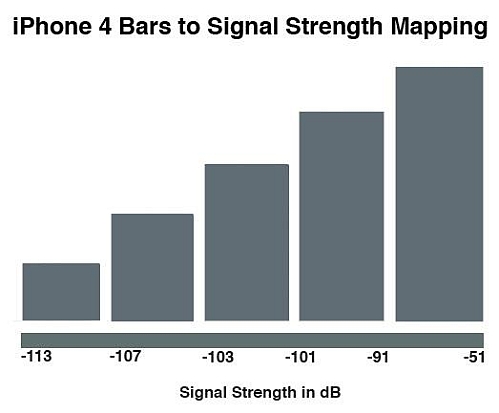
Yet, Apple claims that the iPhone 4 reception problem doesn’t exist. The company insists that the “dramatic drop in [signal bars] is explained by an erroneous iOS 4 signal display,” where 2 bars is reported as 4 bars and 3 bars is reported as 5 bars. In other words, they claim that iOS 4 on the iPhone 4 is reporting 2 more bars than it should, and promise that a software update will fix the way the device displays signal bars. Unfortunately, they don’t claim that this proposed software patch will solve the signal attenuation problem that Brian and many other have demonstrated. Gizmodo has posted a nice thorough analysis of Apple’s position and its contradiction to a realistic fix for iPhone 4 users.
On the other hand, the wireless antenna experts at AntennaSys have written a lengthy blog after having been contacted by numerous news organizations for an adequate explanation of the issue. They claim that the iPhone 4, and other 2010 smartphones including the Google Nexus One, several Nokia models and the HTC Droid Incredible, may all suffer from this problem due to FCC restrictions on antenna design, which happen to force antenna placement in an area where people are likely to hold the device.
This explanation lines up almost perfectly with our theory that the FCC is holding back some information from the public eye regarding iPhone 4 internal hardware specifications. In the few months prior to the iPhone 4’s launch, the FCC had been privately testing the device in order to clear the market approval process. These tests typically include SAR (Specific Absorption Rate) plots on the device’s various antennas, internal photos, external photos, testing verification documents and manufacturer declarations.
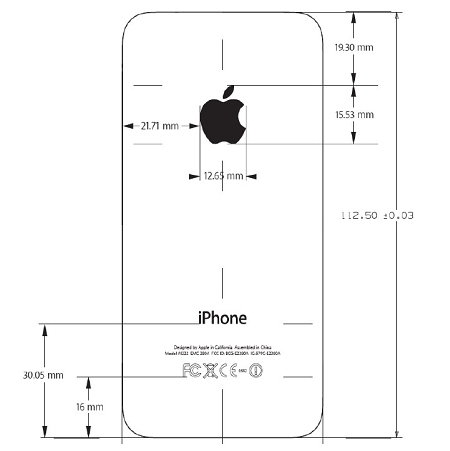
For some unknown reason, Apple was able to ask the FCC for an indefinite confidentiality on some of the device’s details that contain information of top priority. In other words, these details will remain exclusively confidential between Apple and the FCC until 90 days have passed from the signing of the agreement on May 31, 2010.
In a blog post on Monday that has fired up another round of pundit attacks, ConsumerReports’ engineers have just completed testing of the iPhone 4 and have confirmed that there is a problem with its antenna reception. However, the bigger news is that the group does not want to recommend the device due to the significance of the signal degradation issue, despite placing it at the top of the latest ratings of smartphones that it just released.
“Our findings call into question the recent claim by Apple that the iPhone 4’s signal-strength issues were largely an optical illusion caused by faulty software that mistakenly displays 2 more bars than it should for a given signal strength. The tests also indicate that AT&T’s network might not be the primary suspect in the iPhone 4’s much-reported signal woes.”
The group also advises that it has found an affordable solution for suffering iPhone 4 users – “cover the antenna gap with a piece of duct tape or another thick, non-conductive material. It may not be pretty but it works. We also expect that using a case would remedy the problem.”
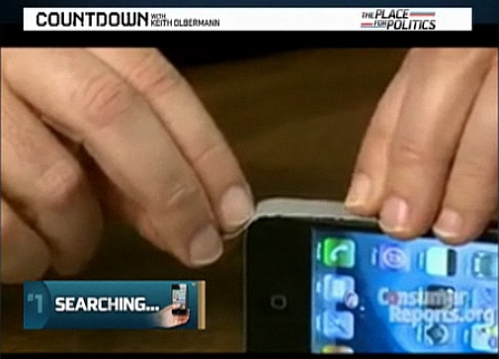
As iPhone 4 hits seem to keep piling up, however, Apple has now found a friend in an electromagnetic engineer who claimed that the recent Consumer Reports study has only replicated the same uncontrolled, unscientific experiments that many of the blogging sites have done.
“To even reasonably run a scientific test, the iPhone should have been sitting on a non-metallic pedestal inside an anechoic chamber,” said Bob Egan, Global Head of Research and Chief Analyst at TowerGroup. “The base station simulator should have been also sitting outside the chamber and had a calibrated antenna plumbed to it from the inside of the chamber.”
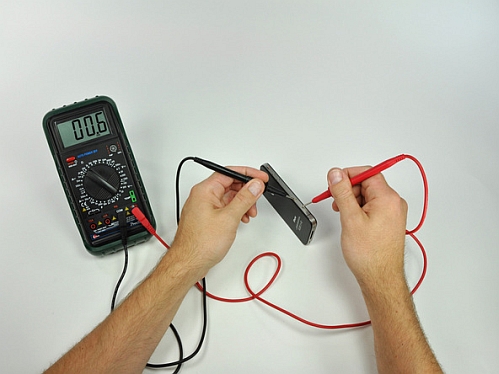
With a credible engineering background and adequate knowledge of RF electromagnetic properties, we are led to agree with Egan. After all, he is simply explaining that the ConsumerReports test is not the authoritative engineering masterpiece that it’s purported to be. He also notes that he’s not refuting the idea that Apple may have a hardware problem, but he cannot determine which part of this issue is Apple’s and which part is related to the AT&T network.
“We also don’t know if placing a finger on the antenna bridge is detuning the antenna or detuning the receiver itself,” he adds. “Mr Jobs, silence is not golden [right now]. I’m quite sure Apple has these answers by now..If not, send me a few more iPhones (I bought three) and I’ll find a chamber and get you some answers in a day.”
As the Wall Street Journal has recently noted, the damage done with this issue may fall on the iPhone’s image of precision-engineered excellence. “It’s negative for the brand,” said Andy Hargreaves, an analyst at Pacific Crest Securities. “But does it mean they’ll sell fewer iPhones? Probably not.”
CPU, RAM and SoC Design Changes
When most companies go through the enormous expense of designing a complex chip, they usually never hesitate to tell the entire industry about it, which in turn riles up prospective consumers through a proliferation of flattery over various social media networks. Whether that information is transmitted through a whitepaper, a keynote, a press release or bite-sized snippets revealed to a select chosen few, word of a new processor or SoC design coming to market almost always materializes before the product hits store shelves. Unfortunately, this has never been the case with Apple. At this point, the company has it pretty much baked into its corporate culture that its secretive product cycle philosophy is one of the best practices it has ever chosen to maintain. Nevertheless, most argue in support of the idea that Steve Jobs simply loves secrets, and that they give him an elevated foothold over an industry filled with assumptions and speculations.
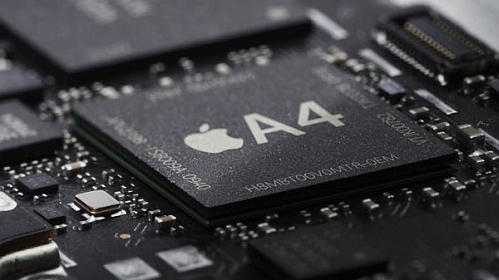
Whatever its motives may be, Apple decided not to reveal the specifications of its A4 processor during the iPad’s announcement in January, and only revealed the name of the processor itself. Of course, little did the industry know that the company would implement the same processor in its fourth-generation smartphone. Now that the product has materialized and has sold over 1.7 million units within its first three days, we can confirm without question that the device sports the same ARM-based 45nm A4 1GHz chip used in the iPad. But rather than being clocked straight at 1GHz, the A4 processor in the iPhone 4 runs at a variable clockspeed, allowing it to vary in speed and adjust according to application demands. It features a maximum clock of 1GHz just like the iPad, but for most applications it will essentially mimic Intel’s SpeedStep platform by adjusting voltages and clock speeds according to the number of applications running to improve power consumption efficiency.
In retrospect, the iPhone 3GS featured a 65nm ARM Cortex A8 with a 600MHz clock speed and 256MB of breathing room. By contrast, the iPhone 4 has been upgraded to a variable clock speed Cortex A8-based SoC that possibly runs between 750MHz and 800MHz most of the time. AnandTech was curious about the exact performance improvements between the two latest iPhone generations and conducted a few SunSpider Javascript performance benchmarks between some of Apple’s top competing 2010 smartphones, including the iPhone 3GS and the iPad. The results show that the iPhone 4 processor manages an overall score that is 25 percent faster than the iPhone 3GS processor in all of its CPU-specific tests. Given Apple’s unwillingness to discuss the architecture of its new phone, AnandTech assumes a safe bet that the ARM Cortex A8-based A4 chip runs around 800MHz in the iPhone 4 and 1GHz in the iPad.
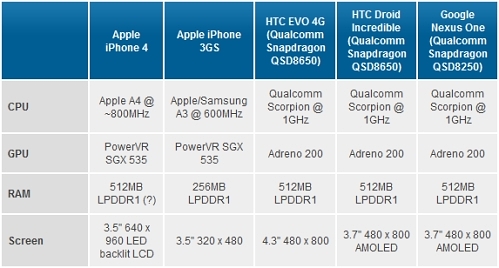
(Flagship smartphone hardware comparison - AnandTech.com)
Memory has also been an interesting topic of discussion in the iPhone 4, as many analysts are now finding that the new device sports 512MB of onboard RAM (503MB of which is available to the OS and applications) opposed to the iPad’s 256MB. This was confirmed by iFixit.com’s teardown of the device right around launch time. The site notes that the increase in RAM allows for a larger amount of cached data, resulting a smoother and faster user experience.
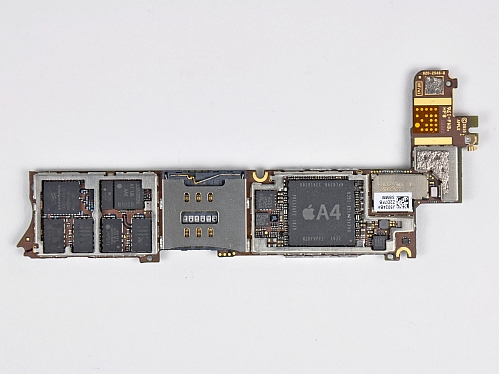
(iPhone 4 SoC - iFixit.com)
Alongside the A4 processor is the same PowerVR SGX 535 graphics chip found in the iPhone 3GS. Anand Shimpi went into great detail last year about Imagination Technologies’ fifth generation PowerVR architecture, a tile-based renderer that divides the screen up into small blocks, or tiles, and renders each one independently. In his iPhone 3GS review, he noted that this approach to graphics rendering is particularly important in the mobile space because there simply isn’t enough available bandwidth, and the mere milliwatts of power that smartphones are intended to consume isn’t enough to drive a full scale rendering architecture.

(Imagination Technologies fifth-generation PowerVR SGX architecture diagram)
From our experience over these past three weeks, the iPhone 4 definitely provides a snappier overall user experience than the iPhone 3GS, and we aren’t ones to complain about any aspects of the CPU/GPU/DRAM hardware combo that Apple decided to implement in this generation. Despite not having a 1GHz Qualcomm Snapdragon processor like the HTC Incredible and HTC EVO 4G, we’ve found that the iPhone 4 adequately meets our expectations and even rivals HTC's offerings in terms of hardware performance (although Apple iOS software performance versus Google Android software performance is an entirely different topic).
We also ran a quick series of SunSpider JavaScript benchmark tests in mobile Safari to more accurately quantify the performance differences between Apple's mobile devices in web browsing. It's important to note that SunSpider tests tend to substitute the "micro benchmarks" found in Google's V8 tests in favor of real-world operations similar to those that developers perform. According to the results, the iPhone 4 sits right in between the 3GS and the iPad.
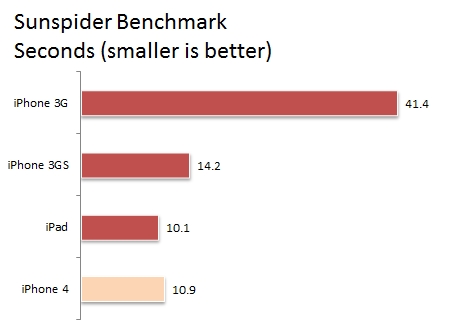
The iPhone 4 hardware also incorporates a new 3-axis gyroscope in addition to the accelerometer. The combination of these two sensors will ultimately provide 6-axis motion sensing (see: PlayStation 3 SIXAXIS Wireless Controller), and using the CoreMotion APIs, application developers can make use of the gyroscope to roll, pitch and yaw. With six degrees of rotation in a compact physical space, Apple hopes that its developers will design even more immersive gaming experiences that enable gamers to have full control over their virtual environments.
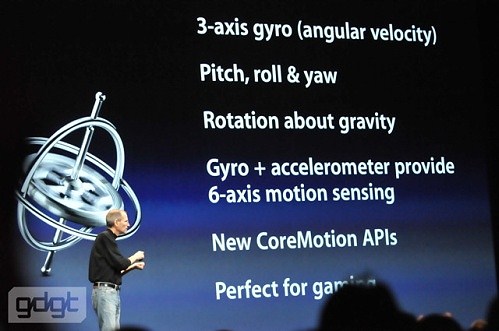
(iPhone 4 gyro announcement during Apple's WWDC 2010 keynote)
Network Improvements and HSUPA Upgrade
In addition to the CPU and memory upgrade, the iPhone 4 benefits from improved network speeds in areas where AT&T has deployed 5.76Mbit/sec HSUPA (High-Speed Uplink Packet Access), a theoretically major improvement over current speeds seen on the iPhone 3G and iPhone 3GS. Over the past twelve months, we have literally ran over 1,200 mobile broadband speed tests all around the Los Angeles / Orange County region of Southern California using the FCC Mobile Broadband Test app and can undoubtedly confirm that the maximum 3G upload speeds on the iPhone 3GS typically average 0.24Mbps and never exceed 0.27Mbps.
Over the past three weeks alone, we have already ran over 700 mobile broadband speed tests with the iPhone 4 and can confirm that our average upload speeds have jumped to 1.12Mbps and top out at 1.24Mbps. In one situation, we even stood 10 feet away from a fairly high-volume local AT&T UMTS tower at various points of the day and managed to find maximum throughput at 3.76Mbps down, 1.22Mbps up and 289ms latency to the nearest packet test server.
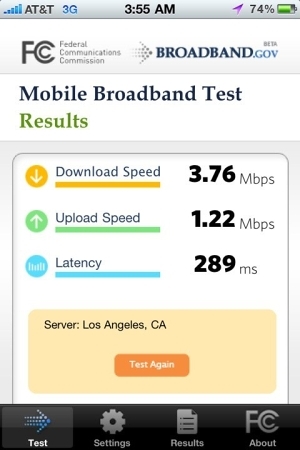
As a side note, we've also consumed over 2.7GB of cellular 3G HSPA data in the past three weeks alone. It looks like AT&T won't be able to take this enthusiast smartphone user off his unlimited data plan in the future without a good fight.
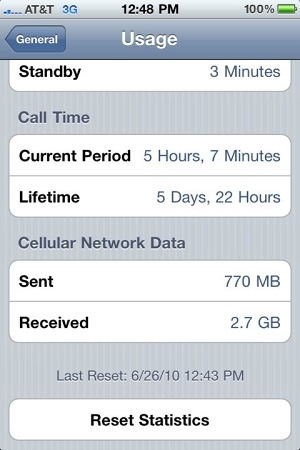
Battery Life
We could go into a much lengthier conversation about the SoC platform in the iPhone 4 and its general hardware performance compared to the previous few iPhone generations. But one of the bigger facets of hardware design that has always concerned the majority of iPhone consumers is battery life. Indeed, Apple's efforts before the iPhone 4 have been a pretty poor selling point in comparison to other smartphones that have made it big in the past 24 months. Nevertheless, the iPhone 4 features a gigantic 3.7V 1420mAh Lithium-Polymer battery, and Apple claims it can get up to 7 hours of talk time on 3G, up to 6 hours of Internet use on 3G (10 hours on WiFi), up to 10 hours of video, up to 40 hours of audio, and up to 300 hours of standby. In comparison, the iPhone 3GS has a capacity of 1219mAh and the iPhone 3G has a capacity of 1150mAh respectively.

(iPhone 4's new 3.7V 1420mAh Li-Polymer battery - iFixit.com)
Based on the teardown images, the battery connector is different than the one in the 3G and 3GS. Fortunately, it isn't soldered to the logic board and should allow battery replacement on the device to be fairly easy to accomplish.
In our iPhone 3GS review last year, we noted that both the iPhone 3G and the iPhone 3GS supply the same amount of juice regardless of Apple's improvement claims at the time. The ARM Cortex A8 crunches through data in a way that, when used at full speed, makes the 3GS run out of battery faster than the 3G. Likewise, the same scenario can partly be said for the iPhone 4. Despite having a larger battery and faster processor clockspeed based on the same architecture, the 800MHz A4 will consume more power at full speed than its 600MHz predecessor, and will consequently cause the phone to run out of battery almost as fast as the iPhone 3GS. Of course, there's a remarkably easy solution to remedy this, and it's built right into iOS 4 - simply close any unused background apps with the built-in task manager by double tapping the Home button and removing them from the selection list. We've noticed that many location-based apps, even when idling as background processes, will utilize the GPS radio and accelerometer for continuous tracking and can drain the battery very quickly. Thankfully, Google Maps doesn't exhibit this behavior, but popular third-party apps like MotionX GPS and Waze can pose a threat to battery life and will attempt to gulp the juice out of the iPhone 4 when unnoticed.
In contrast to the nature of battery consumption in Apple's rendition of multitasking, the iPhone 4 has a very impressive standby time under normal to light usage. We tested the phone overnight with an initial charge of 100 percent battery and checked up on it 14 hours later to find that it had only dropped to 98 percent. This behavior is similar to what the iPad exhibits when fully charged under normal to light usage. Overall, we're thankful that the new A4 architecture sips power under normal use conditions and can potentially spare us a few extra hours of standby time when the battery dips down to 6 percent and we're stuck in an emergency situation without a charger (hey, it happens to all of us).
Front and Back Cameras - New CMOS Sensors
Since the introduction of the original iPhone in summer 2007, the iPhone 4's camera system has been by far one of the more significant overhauls that the platform experienced and has been a notable topic of discussion since WWDC 2010. The original iPhone launched with a fixed-focus lens and a contemptible 2 megapixel CMOS sensor that lacked the capacity to produce any meaningful low-light, motion or close-up shots worth keeping. After twelve months came and went, the iPhone 3G appeared on the scene with the exact same sensor and produced almost identical shots with very subtle lighting improvements. Another twelve months went by, and the iPhone 3GS launched with a 3 megapixel sensor, autofocus, and a "tap-to-focus" system to link the focus control and autoexposure system to a specific point in the image. As many came to notice, it was also the first iPhone sensor capable of shooting VGA-quality video clips, however very limited in resolution. Despite the improvements over this 2-year product cycle, many critics remained unimpressed with these hardware changes and desired a product with image quality more resemblant of an amateur, pocket sized point-and-shoot camera.
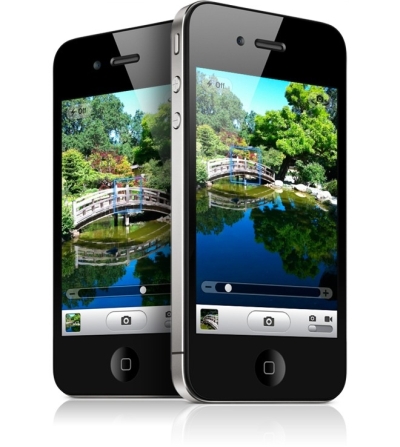
During his WWDC 2010 keynote, Steve Jobs said that getting great looking images wasn't just about increasing the camera's megapixels. It had more to do with grabbing more photons from the ambient environment. By increasing the photon count, more light gets let into the sensor, and images will look noticeably better. Let's take a look at the sensor differences between the iPhone 3GS and the iPhone 4.
The iPhone 3GS features a 3.1MP, 1/4" CMOS sensor from OmniVision. According to Apple, that sensor has 1.75µm pitch individual pixels. In contrast, the iPhone 4 features a 5MP, 1/3.2" CMOS sensor with backside illumination. By increasing the size of the sensor itself, the size of the individual pixels remains the same at 1.75µm pitch, but the backlit sensor has circuitry on the back of the chip, keeping it out of the way of light and effectively allowing more light to reach individual photo diodes in each pixel location.
During the weekend of iPhone 4 launch day, we attended a concert by one of our favorite bands in San Diego and attempted to capture our very first iPhone 4 snapshots using the new backside illuminated CMOS sensor. The results were quite impressive, the quick response time of the autofocus lens significantly enhances the value of capturing motion shots by improving shutter lag.

5 megapixel still shot (2592x1936) taken at Moonlight Beach in Encinitas, California. Full resolution here.

5 megapixel action shot with 5x Digital Zoom taken at Moonlight Beach in Encinitas, California. Full resolution here.

5 megapixel night shot taken in Cypress, California. Full resolution here.
The fact that Steve Jobs even mentioned the specifications of the new CMOS sensor during WWDC is a sign that Apple is taking the camera much more seriously with this generation. Based on the product brief published by OmniVision, "the OV5653 delivers the industry's best low-light sensitivity of >1300mV/(lux-sec) - a 40 percent improvement over previous FSI devices - and a 2x improvement in signal-to-noise ratio (<70lux)." ArsTechnica recently held an interview with Dr Eric Fossum, an expert in CMOS image sensor technology, about the importance of backside illumination for digital cameras. "Backside illumination was essentially devised for the mobile market—as sensors continued to shrink, something was needed to increase the sensitivity," said Dr Fossum. In addition, Chris Foreman from ArsTechnica dives into the specifics behind Apple's new CMOS sensor, why some pixels are more equal than others, and how the iPhone 4 offers a sizable amount of photo and video power for the average user.

(OmniVision OV5653 5MP 1/3.2" CMOS sensor with backside illumination)
The iPhone 4's backside camera also brings with it a new complementary LED-based flash on the right hand side. At the top left of the Camera app in iOS 4, there is a translucent button that allows a user to set the flash to Auto (default), On or Off. The controls work for both still shots and video, and is particularly useful for capturing night video. We've also found that the LED flash doubles as a reasonably bright flashlight almost equivalent to a typical Performance LED Pocket Flashlight, but with more light focused in a central location.
In terms of image clarity, the iPhone 4's front-facing camera captures still shots and video at a mediocre VGA resolution (640x480). We might also add that it's idealistically convenient for taking quick portrait snapshots either alone or with another person, although there is somewhat of a "fish eye" lens effect that gives an unrealistic facial perspective on pictures that are shot too close up.
As with the iPad, the iPhone 4 now offers support for 720p H.264 video playback and motion JPEG video playback. This is a huge leap over the maximum 640x480 playback resolution on the iPhone 3GS. Consequently, videos from the iTunes Store designated as "HD" will now play on the iPhone 4 as well as unconverted .AVI formatted M-JPEG HD videos made on a select list of cameras, including some recent Nikons. For some reason, however, MPEG-4 videos recorded at 1280x720 on other video cameras will not play on the iPhone 4 without a transcoding. Apple has also indicated that the iPhone 4 is compatible with the iPad Dock Connector to VGA adapter, currently the highest-resolution video output solution available for the iPhone 4 and the iPad. Unfortunately, the dock does not provide audio output and the video output resolution is capped at 1024x768, modestly below the 1280x720 playback capabilities of the iPhone 4.
FaceTime Chat and Video Recording
As far as video capture is concerned, we are definitely impressed by the 1280x720p video capture with the new OmniVision CMOS sensor, although there are some stability issues with the lens. As Engadget Editor-in-Chief Joshua Topolsky notes, there is an all-too-familiar "jellyvision" CMOS issue that results from the sensor not having an anti-jitter algorithm, so it's crucially important to keep steady hands at all times when recording any video with the iPhone 4.
After a week and a half of casual video capture around the neighborhood, we wanted to take our new smartphone into an extreme environment to determine how persistent the "jellyvision" effect would be under very shaky circumstances. Last weekend, we attended Rockstar Mayhem Fest 2010 in San Bernardino, California and recorded our brutally epic experiences in the mosh pits while fists were being thrown around and heads were being crushed all around:
On the other hand, the front-facing VGA camera does an adequate job of capturing facial features and works surprisingly well in low-light environments. However, as we've mentioned, it's best to hold the iPhone 4 at least arm's length away in order to reduce the "fish eye" lens effect that may result if held too close.
This bring us to the topic of FaceTime video chat with the front-facing camera. In iOS 4, Apple has enabled the feature by default and allows iPhone 4 users connected via WiFi to initiate an outgoing video call by tapping on a contact's entry in the Contact Book and tapping the FaceTime button. For some reason, the iPhone 4 will apparently show the "FaceTime" call button for every contact in the address book regardless of whether or not that contact has an iPhone 4. We are convinced that Apple may eliminate this unnecessary display in the upcoming iOS 4.1 software fix, but as for now it may cause confusion to regular mobile videoconferencing users.
We have tested the FaceTime feature on several home networks with minimal latency and can attest to the fact that the video quality is much crisper and sharper than we had originally expected. In comparison to Qik for the HTC EVO 4G, the iPhone 4's 960x640 Retina Display gives it leverage in the video conferencing department for sharpest picture. However, the audio quality during a FaceTime call is no different than a standard phone call, and we are a bit disappointed that Apple decided to use the same audio codec for both communication protocols despite the increase in bandwidth availability over WiFi.
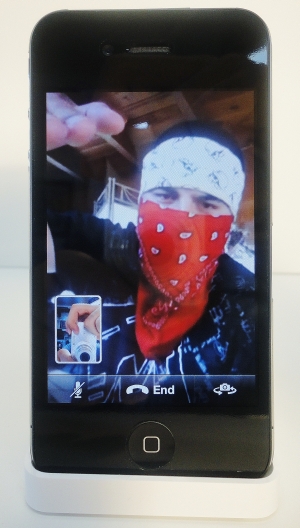
(FaceTime chat with a thug, in portrait mode)
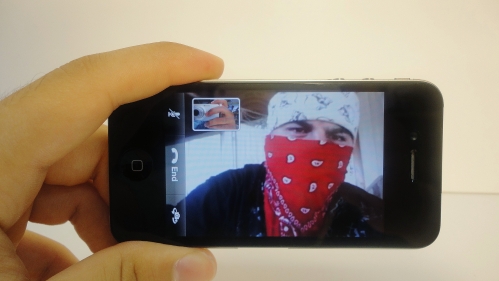
(FaceTime chat with a thug, in landscape mode)
On another note, if standby mode is entered by pressing the iPhone 4's power button during a FaceTime call, the video will be disconnected and the iPod audio will be paused. Once the screen is turned back on, the FaceTime call will have already been closed, and the iPod audio will then be accessible for playback. We are also able to confirm that FaceTime audio and iPod audio can play simultaneously, with neither audio source having volume preference over the other.

(FaceTime conference multitasking with iPod audio playback)
Market Acceptance
It has been three weeks since Apple launched the iPhone 4 in the United States, the United Kingdom, France, Germany and Japan, with an international release set for July 28th. The phone was originally expected to become the most popular i-Product in history. Yet, we can confirm that this smartphone went above and beyond this achievement and sold over 1.7 million units in just 72 hours of launch. At the third week mark, it has probably sold more than 2.5 million units, but this figure remains to be confirmed.
"This is the most successful product launch in Apple's history. Even so, we apologize to those customers who were turned away because we did not have enough supply,” Apple CEO Steve Jobs said in a press release. At 1.7 million handsets sold in four short days with limited supplies, Apple grew its worldwide iPhone installed base by 3.4% to 51.7 million over launch-day weekend. In contrast, the iPad needed 80 days to reach 3 million sold when it launched earlier this year on April 3rd. Although not a necessary news flash to cite within this review, Apple has also surpassed Microsoft in total market cap as the most valuable IT corporation in the world.
After all, approximately 77 percent of iPhone 4 buyers on launch day were upgrading from a previous iPhone. It is safe to say that Apple has successfully built a recurring revenue stream in which most users will upgrade every one to two years, provided they receive upgrade incentives from AT&T in the form of subsidies. It is important to note, however, that the level of brand loyalty Apple has garnered is a significant factor in opening weekend sales and the success of its platform. According to an analyst report from Gene Munster, “The bottom line is this: 77 percent of new iPhone buyers were existing iPhone owners (upgrades), compares to 56 percent in 209 and 38 percent in 2008.”
The same survey also suggests that both 16GB and 32GB models of the iPhone 4 are being sold at roughly the same rate. Of the total respondents surveyed on iPhone 4 launch day, 54 percent of them had plans to purchase the 32GB model while 46 percent had plans to purchase the 16GB model. Whether those numbers held true during actual sales transactions remains to be seen, but the data suggests that many iPhone users do not express a need to fit more than 16GB of storage in their pockets.
We are led to assume that perhaps the company’s marketing team had already predicted this outcome and kept the 16GB and 32GB models for the sake of maintaining profit margins. Back in December 2009, Toshiba announced its largest 64GB NAND-flash chip, the highest capacity yet achieved in the industry. Of course, rumors abounded that Apple wouldn’t hesitate to include this new 64GB module in its fourth-generation iPhone lineup, but the announcement at WWDC 2010 and release on June 24th shows that it didn’t happen.
It’s still interesting to point out that within Apple’s third-generation iPod touch lineup, released in September 2009, there is a 64GB model available for $399. Based on this observation, we are confident that Apple’s fifth-generation iPhone lineup next summer will include a 64GB model, but we won’t have a confirmation for quite some time.
Conclusion
The iPhone 4 is an incredibly unique smartphone device that builds on a 3 year tradition in the Apple mobile product ecosystem. For the average consumer, it offers a significant improvement in battery life over its predecessors and promises to deliver up to 7 hours of 3G talk time and up to 6 hours of continuous Internet browsing over 3G. As a device for making voice calls, it has enough juice to last throughout an entire day and provides an incredible amount of standby power even in the most extreme conditions where battery percentage is barely hanging in the single digits.
For the enthusiast consumer, its variable clockspeed A4 SoC and 512MB of system memory are adequate enough to provide a seamless multitasking experience within the iOS software platform. From a network perspective, the improved baseband hardware gives the iPhone 4 more performance as a cloud-based mobile device and delivers exceptionally improved HSUPA upload speeds in the range of 1Mbps - 1.24Mbps with lower latency than its predecessor. It's conveniently useful for any context where uplink and downlink data throughput rates are of highest priority, and as far as we recall, AT&T is still the fastest 3G HSPA network in the United States (not HSPA+) despite many ongoing grudges towards its service. Simply put, Apple signed an exclusive 5-year agreement with AT&T, and both are required legally adhere to strict terms and agreements until that contract expires in summer 2012. If a cynical argument is going to exist about network quality and coverage, it's going to be with AT&T rather than with Apple.
For each and every consumer in the smartphone market, the iPhone 4 features a surprisingly high-end front and back camera system that allows users to capture still shots and videos with confidence in an improved 5MP 1.3/2" CMOS sensor with lightning fast shutter speeds in comparison to other flagship smartphones available in Q3 2010. Apple has also gone above and beyond many expectations with its Retina Display, a 960x640 326ppi IPS-based LCD that single handedly outshines any competitor in terms of resolution density and image clarity at this point in time.
As many analysts have noted, there are some viable alternatives to the iPhone 4 that may have an almost identical feature package but a slightly different form factor (and operating system for that matter). Nevertheless, when it comes to the total package - the iPhone 4's compact hardware form factor combined with its exceptional display, snappy Cortex A8-based A4 processor and 512MB of memory provide an incredibly productive mobile computing landscape within iOS and serve all of our day-to-day purposes with ease and without complaints.
